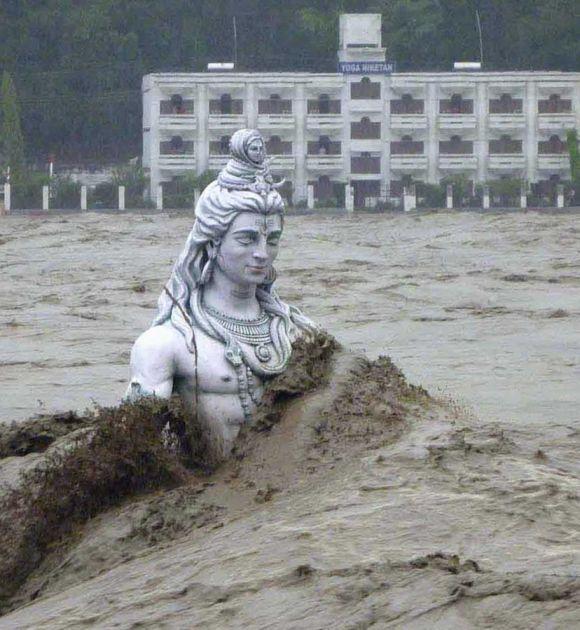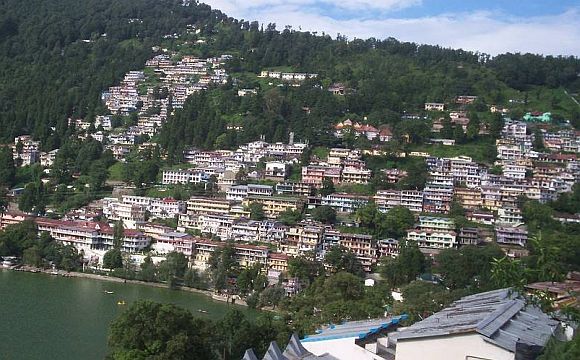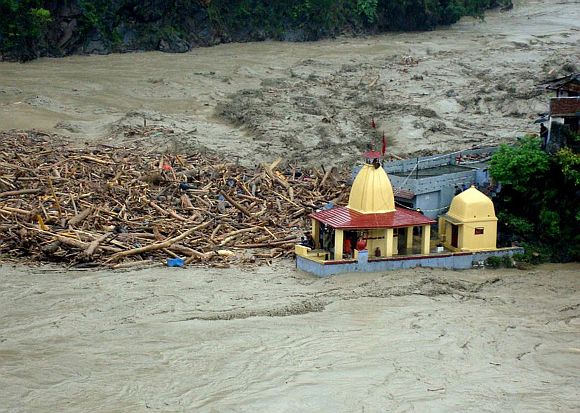 | « Back to article | Print this article |
It was a disaster waiting to happen, and it DID!
The Ministry of Environment and Forests has decided to step in, though late in the day, asking the Uttarakhand government to stop any construction along the river bank.
Even as the jury is still out on whether the destruction in the state is man-made or caused by nature’s fury, there’s sufficient evidence to suggest that warnings were loud and clear much before the disaster struck.
The Union ministry, which could now seek demolition of illegal structures on riverbeds, had sounded the alarm bell last year on the adverse impact of unrestricted constructions in the region.
Warnings ignored
A study conducted on Uttarakhand hydro-projects by the Wildlife Institute of India under the MoEF in 2012 said that of the 1,121 km stretch of rivers that flow in the entire Alaknanda and Bhagirathi basins, at least 526.8 km, or 47 per cent of the basin, could be affected due to illegal construction along the river bank.
Click on NEXT to read further...
It was a disaster waiting to happen, and it DID!
Also, a Comptroller and Auditor General (CAG) report three years ago had stressed that there was a hydro-electric project every 5-6 km, with more than 40 projects already operational and many readying to come up.
This, CAG had said, was a serious threat to nature and bio-diversity of the region.
Not only that, MoEF had earlier questioned the state government on the need for so many small power projects that are below 2 mega watt on the Ganges.
Illegal construction
Apart from the power projects and dams, illegal motels (small hotels) and residential complexes have mushroomed close to the river beds to tap rising number of tourists in the area.
An executive from a real estate firm, not wanting to be identified, admitted there were illegal buildings all around. Seeing it as a source of income, many residents have converted part of their houses into guest houses, with rents in the range of Rs 1,000-2,000 a day.
Click on NEXT to read further...
It was a disaster waiting to happen, and it DID!
In addition, many local developers get into the business of hotels and guest houses in states such as Uttarakhand and Himachal Pradesh, violating many building rules, to be able to make quick bucks, another realtor pointed out.
However, Naredco (National Real Estate Development Council) Director-General R R Singh argued that the current disaster was due to landslides and that there was no problem with real estate development in the region.
“The buildings, which came up must have been approved by local authorities. Being a hilly terrain, all the construction was done on slopes, which will be washed away by landslides, irrespective of the quality of the material used,” said Singh.
While the official death toll due to the floods is around 150, more than 1,000 people are feared dead and many more stranded across Uttarakhand.
Click on NEXT to read further...
It was a disaster waiting to happen, and it DID!
A top environment ministry official said that once the rescue operation is over, the ministry would seek explanation from the state government on un-restricted development along the banks of the rivers.
“We would ask for immediate removal of all existing structures on riverfront. The major issue there is not the dams, but the illegal constructions that were allowed,” said the official.
“We would ask them (Uttarakhand government) to review all those plans that are not nature-friendly. The entire affected area was part of eco-sensitive zone plan and it should not be compromised for development work,” the MoEF official added.
According to estimates, there are at least 600 small and large hydro electric power projects within the state.
At the moment, apart from national highway projects and mega infrastructural projects, none of the major projects in the state is cleared by MoEF.
Click on NEXT to read further...
It was a disaster waiting to happen, and it DID!
Environmentalists, meanwhile, have put up their demands.
“There should be cumulative impact assessment that the MoEF should do in Uttarakhand related dams and projects along the banks of rivers,” said Himanshu Thakkar, co-ordinator of South Asia Network on Dams, Rivers and People.
As for damage control, the National Disaster Management Authority has deployed 13 teams of the National Disaster Response Force with 7,000 members, including 4,000 army men. The State Disaster Mitigation and Management Centre team is also in action.
“There is a joint command for all these co-ordination works. The major problem for us is communications, because the only mode to conduct rescue work is through air or by foot,” said J K Sinha, member, National Disaster Management Authority.





